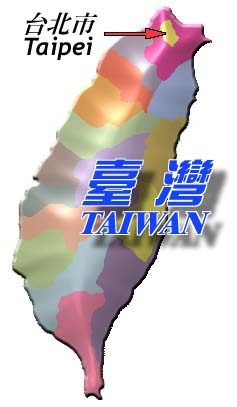
Copyright © 2003 Taipei City Government
Introduction to Taipei
Location
Located in northern Taiwan, Taipei is the political, economic, financial,
and cultural center of the Republic of China. It has a thriving arts and
academic scene and countless modern commercial buildings. With its vibrant
cultural and economic growth, it has become a modern international metropolis.

Copyright © 2002 Taipei City Government
Geography
Taipei is nestled in a basin with mountains on all sides and covers an area of
27,177 hectares. Two beautiful peaks rise up steeply in the northeast: Mt. Tatun
and Mt. Chihsing, both just over 1,000 meters high. Volcanic formations, they
are gentle in shape, contrasting with Taiwan's other harsh, jagged peaks. By
virtue of this unusual topography, the area was made into Yangmingshan National
Park.
History
Taipei is the ancestral homeland of the Kaidagelan, a plains aboriginal
people. The Han Chinese first arrived at the beginning of the Ming dynasty
(1368-1644). During the early 17th century, the Spanish began occupying the
region and were followed by both the Dutch and Ming loyalist Cheng Cheng-kung (Koxinga).
Up to the Ching dynasty, the area was wild and undeveloped and was considered
beyond civilization.
The history of Taipei's development didn't
begin until 1709, when Chen Lai-chang, a native of Chuanchou, Fukien Province,
applied for permission from the government to develop the region. He started out
in the Tachianapao area (present-day Taipei), with Mengchia (present-day Wanhua)
being the first district to be developed. Due to its convenient access to water
and a natural harbor, it became the trading center of the Taipei Basin.
Immigrants from Chuanchou moved to the Tataocheng area in 1853, beginning a
period of prosperity and development in the region.
In
1875, Shen Pao-chen petitioned the Ching government to establish Taipei City.
Work began in 1882 and was completed in 1884. The entire city was rectangular in
shape. In 1887, Taiwan was officially made a province, with Taipei as its
capital and Liu Ming-chuan as its first governor.
In
1895, after China's defeat in the Sino-Japanese War, Taiwan was ceded to Japan
and became a colony.
Taipei was torn down and redesigned three times
by the Japanese before eventually taking on the proportions of a big city.
Following its retrocession to China in 1945, Taiwan was
re-established as a province. Four years later, the Central Government
relocated to Taiwan and made Taipei its provisional capital. The city gradually
prospered, and on July 1, 1967, it was raised to the status of a
special municipality directly administered by the Central Government.
After the reorganization, Taipei rose in prominence to become the political,
economic, educational, cultural, and transportation hub of the country. Thirty
years and two administrative restructurings later, it has transformed itself
into an international city.
Population
2.63 million (approx.)
Language
Mandarin Chinese is the official language. Taiwanese, Hakka,
and other dialects are also spoken.
Climate
Taipei has a subtropical climate, with an average temperature of
23.6 degrees centigrade (74.5 degrees Fahrenheit). Summer is from May until
September and is characterized by scorching heat and high humidity. Average
temperatures range between 25.2 and 28.6 degrees centigrade. Autumn is from
October to November, with average temperatures ranging between 22.2 and 24.2
degrees centigrade.
(Source: Central Weather Bureau, 1997)
Winter
is from December to February. The weather is cold, with temperatures ranging
from 15.3 to 18.5 degrees centigrade.
The rainy season is from April to May, but may last to September. In
spring, Taipei is abloom with azaleas and the temperature hovers between
19.1 and 21.7 degrees centigrade.
Copyright © 2003 Taipei City Government
¡@
@ Home¡@